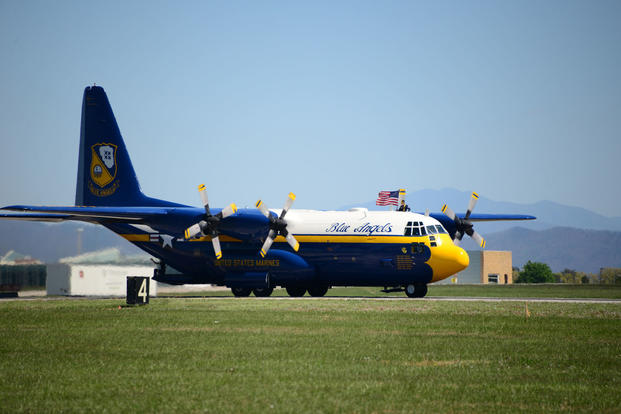Nearly three months after the horrific crash of a Marine KC-130T transport aircraft resulted in the deaths of all 16 troops aboard, the Navy and Marine Corps have yet to lift a no-fly order affecting all similar aircraft in their inventory.
Some 23 Navy C-130Ts and 12 Marine Corps KC-130Ts, among the oldest variants of the C-130 Hercules still in the air, have been grounded as military officials complete an investigation into the July 10 tragedy.
The number includes Fat Albert, a C-130T with a Marine Corps crew that provides logistics and transportation to the Blue Angels, the Navy's elite aerial demonstration team. The brightly painted aircraft was absent from the EAA AirVenture Oshkosh air show in Oshkosh, Wisconsin, at the end of July and has since missed seven shows across the country during the team's busy summer season.
The other aircraft affected by the grounding belong to Navy and Marine Corps Reserve units, officials with both services said.
"The C-130T aircraft are still on an operational pause, however, the Navy and Marine Corps are working together to meet global lift requirements while the ongoing investigation of the KC-130T incident comes to a conclusion," Lt. Russell Chilcoat, a Navy Reserve Forces spokesman, said in an email to Military.com. "In the meantime, the Navy is maximizing operations by utilizing various unaffected aircraft in the inventory to meet mission demands."
Capt. Andrew Chrestman, a spokesman for Marine Corps Forces Reserve, said the single New York-based squadron owning the grounded KC-130T aircraft, Marine Aerial Refueler Transport Squadron [VMGR]-452, is staying busy with other tasks while the aircraft are sidelined.
"The op pause is still in effect, but the squadron has been keeping its pilots and flight engineers current and ready through the use of simulators," he said. "There is also quite a bit of ground operations, maintenance and inspections that continues to keep the maintainers, crew chiefs and crew busy and gainfully employed. The squadron is also continuing to prep for mobilizations and the FY18 exercise season."
For the Blue Angels, however, the absence of "Bert" leaves a more pressing demand.
Marine Maj. Dusty Lee Cook, who piloted Fat Albert for the Blue Angels from 2013 to 2015, told Military.com the team used the plane to fly some 35,000 pounds of gear, plus a team of 40 maintainers, to various locations around the country for shows.
"When we say 'the workhorse,' people joke about it, but when stuff needs to happen, people go, 'Where's Bert?'" Cook said.
Fat Albert also typically plays a role in the show itself, completing a 10-minute demonstration showcasing the massive aircraft's aerial capabilities.
"There's nothing aerobatic about it. We don't do any of that, but we max perform the airplane just as we would in the fleet," Cook said.
It's not the first time, that Bert has been out of commission.
In 2014, Cook said, he hit a bird while flying Fat Albert, and the plane was subsequently grounded for several months. He recalled at least one prior incident as well when the aircraft had been temporarily sidelined.
When that happens, he said, the Blue Angels rely on borrowed lift capability from other military squadrons and sometimes resort to slower ground transportation for show set-up and take-down.
"We may get a loaner -- we call it Ernie," he said. "Usually we'll baby the hell out of that Ernie airplane; we won't fly a demonstration with that plane."
Lt. Joe Hontz, a Blue Angels spokesman, said the team is currently utilizing C-130J Super Hercules aircraft from various Marine Corps squadrons to transport equipment and personnel, as well as some Navy C-40 Clipper planes for longer trips.
For now, Hontz said, there are no discussions about upgrading to a newer airframe for Fat Albert, and it remains unclear when the aircraft will resume normal operations with the team.
The investigation into the recent crash, which officials said occurred after something went wrong at cruising altitude, remains ongoing, and no findings have yet been made public.
-- Hope Hodge Seck can be reached at hope.seck@military.com. Follow her on Twitter at @HopeSeck.





























